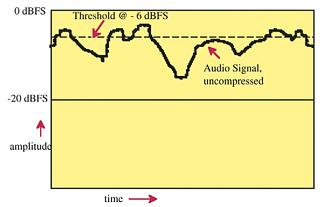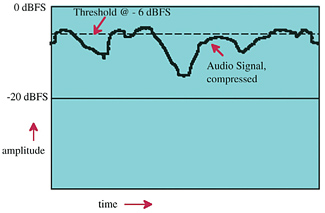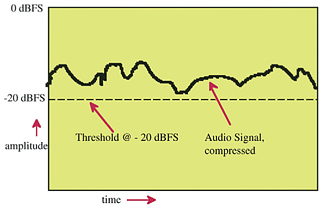Thinking About Compressors

As you may recall, I've been ranting about levels in television production for the past six months, at least. I thought it might be nice to take a moment to consider the primary tool we use to cope with such audio mayhem. That would be, of course, the audio compressor.
This is a fascinating device. We use it a lot. However, our understanding of it is a little, ah, limited.
The compressor has some fairly tricky controls. Its action can be hard to hear if it's used well, and mostly, it isn't understood all that well by those of us who use it. It has the further characteristic of coming in a wide range of shapes, sizes and flavors, sometimes described in rather exotic terms that are often hard to understand.
It often is cloaked in retro mysticism (as in "Oh man, that old tube (insert brand name here) compressor does better on everything than any modern compressor. They should never have stopped making it!"). Sometimes, it is an extremely complex device (as in multiband compressors) and sometimes it is pretty tricky as well (as in "look-ahead" compressors).
SO WHAT DOES A COMPRESSOR DO?
A compressor is a device that regulates the gain or level of an audio signal as a function of (usually) the changes in amplitude of that signal, according to a fairly complex set of rules. Sometimes we use it to prevent overly loud signal peaks from distorting, and sometimes to smooth out the level variations to make a signal (particularly a voice signal) more continuously and easily audible. Sometimes we use it to reduce the overall dynamic range of an audio signal.
All compressors work by sending the incoming audio signal through an active gain stage (usually a voltage-controlled amplifier or its digital equivalent). At the same time, the signal is also sent, in parallel, to a so-called level detector, which studies the signal and converts it into a control voltage (or digital equivalent).
Said control voltage is manipulated in a variety of clever ways (here's where each compressor gets "its own sound") and then regulates the gain of the active gain stage. What could be simpler?
For instance, if the control voltage is inverted so that as the amplitude of the audio signal gets greater the control voltage is reduced, then the net result will be that as the audio signal gets louder, the gain stage will make it softer, hence "compressing" its dynamic range. Got it? Good.
If only it were that simple...

Fig. 1: A hypothetical uncompressed audio signal ranging between approximately -3 dbFS and -16 dbFS In actual fact, we want the compressor to do a bunch of other things for us. This month we'll consider the Threshold control, which is probably the most important control on any given compressor.
WHAT DOES THE THRESHOLD CONTROL DO?
Over the years we've learned that what we really want most is for the compressor to leave the level of the signal alone, except for various embarrassing peak levels that are causing overloads and distortion. Hence, we came up with a control called the "Threshold."
This Threshold control sets the level above which there will be acts of compression occurring. Below that Threshold level, there will be no changes in the level of the signal due to the compressor. Got that?
In an analog compressor, the Threshold level is usually expressed in dBu (or dBm), and calibrated from something like +20 dBu down to –20 dBu. In the digital realm, Threshold level is given in dBFS, from 0 dBFS down to –40 or even –60 dBFS. Let's study the implications of this for a moment.
WHAT HAPPENS WITH A HIGH THRESHOLD LEVEL?

Fig. 2: This is the same audio signal in Fig. 1, now compressed above the -6 dbFS Threshold
Let's set the Threshold in a digital compressor at –6 dBFS for a moment, to discuss what would happen. When the signal level is at or below –6 dBFS no compression of any sort happens. What comes in goes out unchanged.
However, when the signal level goes above the Threshold set at –6 dBFS, compression occurs, and the compressor reduces the level of the signal by some amount (determined by another control called the Ratio, which I'll talk about another time).
This means that as signals approach 0 dBFS they are turned down in level, so hopefully they won't distort.
With this setting, then, very little would happen except when peak signal levels exceeded –6 dBFS, in which case they would be turned down to avoid overloads. Make sense?
WHAT HAPPENS WITH A LOW THRESHOLD LEVEL?
However, if we set the Threshold at, say, –20 dBFS, a lot more compression will happen. First, everything above –20 dBFS (which is probably almost the entire signal trace) will be turned down by the amount determined by the ratio control. So virtually all the audio will be compressed in range, which is quite definitely audible in most cases. In crude or excessive usages this is referred to as "squashing"—sounds right to me.

Fig. 3: This is the same audio signal as in Figs. 1 & 2, but with a -20 dbFS Threshold So, depending on how the Threshold is set, a lot or a little can happen to the signal, from nearly inaudible to extremely audible. Take a look at Figs. 1–3.
Fig. 1 shows a hypothetical uncompressed audio signal ranging between approximately –3 dBFS and –16 dBFS. The Threshold is set at –6 dBFS, but is not active.
Fig. 2 shows the same audio signal, now compressed above the –6 dBFS Threshold. Note that there is very little change, except for the peaks—what was –3 dBFS is now –5 dBFS. Very subtle, but it means you could turn up the level by 5 dB without trouble if you wanted.
Fig. 3 shows the same signal, but with a –20 dBFS Threshold. Now we've done some serious squashing. What was formerly –3 dBFS is now –12 dBFS and what was formerly –16 dBFS is now –18 dBFS. The dynamic range of the signal was originally 13 dB—it is now 6 dB—dramatically different. If we wished, we could turn it up by 11 dB without overload. It might not sound so good, but we could do it.
IN OUR NEXT EPISODE...
Obviously, there is much more to this. In my next column I'll go a little farther with this, and discuss Make-Up Gain and Ratio. Then maybe we'll be ready to talk about Attack and Release.
Thanks for listening.
Dave Moulton is feeling a lot of compression in his finances, and his threshold seems to have been turned way, way down. You can complain to him about anything at his Web site,www.moultonlabs.com.
Get the TV Tech Newsletter
The professional video industry's #1 source for news, trends and product and tech information. Sign up below.

